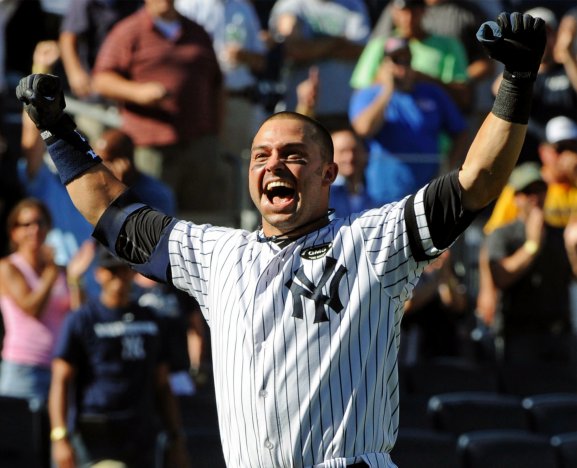
Contrary to what baseball traditionalists might tell you, hitting .300 is not that important. There are more important things in baseball than getting a hit three times in every 10 official at-bats. Hitting for power and getting on base are equally important, and while they can be part of batting average they aren’t necessarily so. In other words, there are many ways to become a productive player, and hitting .300 is only one of them. Still, it’s an interesting feat that still carries some power in today’s game. It becomes even more interesting when an unsuspecting player reaches the plateau.
Nick Swisher hasn’t been anyone’s idea of a .300 hitter for a while now. At Ohio State he hit .299, .322, and .348, but once he hit the minors that average started to dip. He compensated by getting on base and hitting for power, but by 2005 it became clear that he wasn’t the kind of guy that would dunk a single over the second baseman’s head. Instead he either crushed the ball, struck out, or took his base. In his first full big league season more than half of his hits went for extra bases, and in 223 of his 522 plate appearances he either drew a walk, struck out, or hit for extra bases.
Swisher experienced a similar effect during his first year in the Bronx. Of his 124 hits, more than half went for extra bases and again nearly half of his plate appearances (288 of 607) resulted in a strikeout, walk, or extra base hit. He hit only .249, which drew the ire of some old school fans, but Swisher contributed greatly to the Yankees 103 wins. His ability to avoid making outs and his power made him a useful player, albeit not in the traditional mold. But this year we’ve seen something completely different.
It was evident early on that Swisher was going to be a different type of hitter this year. He started swinging earlier in the count and was lining pitchers over infielders’ heads for singles. He started hitting bleeders through the hole. He stopped taking so many walks. It’s not that Swisher stopped being so patient; he’s still 20th in the AL in pitches seen per plate appearance. But he is definitely looking early in the count for pitches he can drive. These don’t necessarily have to be meatballs, but simply pitches that he can hit on a line. It has worked so far, as he currently sports a .288 batting average.
A knee injury has kept Swish either out of the lineup or ineffective for most of September. He’s just 3 for 26* this month, dropping his average from .296 to its current .288. That will certainly hurt his chances at hitting .300. Health is obviously a priority over an arbitrary milestone, but it would still be nice to see Swish reach that this year. He doesn’t have much time left to make it up.
*Yeah, and 1 for 1 in walk-off opportunities.
Assuming he gets the weekend series off, he’ll have 12 games in which to add 12 points to his batting average. At 4 PA per game that’s 48 remaining, but let’s say 50 since there are plenty of games in which he’ll appear five times. He’s walking in 9.3 percent of PA so far, so let’s assume five walks the rest of the way. That’s 45 AB added to his current 507, so 552. With that many AB a player would need 166 hits to reach .300. Swisher currently has 146, so he’d need to go 20 for 45. Doing that would go a long way in the Yankees clinching a spot early, but it’s not very likely at all.
While .300 is all but unattainable, it shouldn’t dampen Swisher’s 2010 season. He was a productive player for the Yankees last year, but he’s been on a different level this year. He’s made enough contact that Girardi has been comfortable batting him second. He’s really fit in there, despite all the strikeouts. Last year we were still wondering who the Yankees starting right fielder would be in 2012; Swisher was thought a temporary player. But now it looks like he could be around for a while. I don’t think anyone is complaining about that.
Leave a Reply
You must be logged in to post a comment.